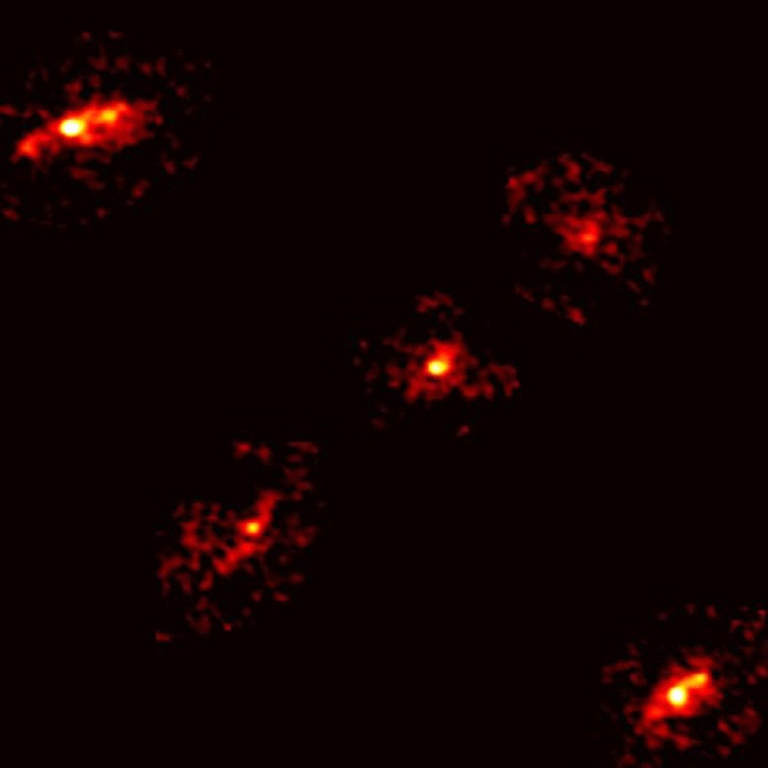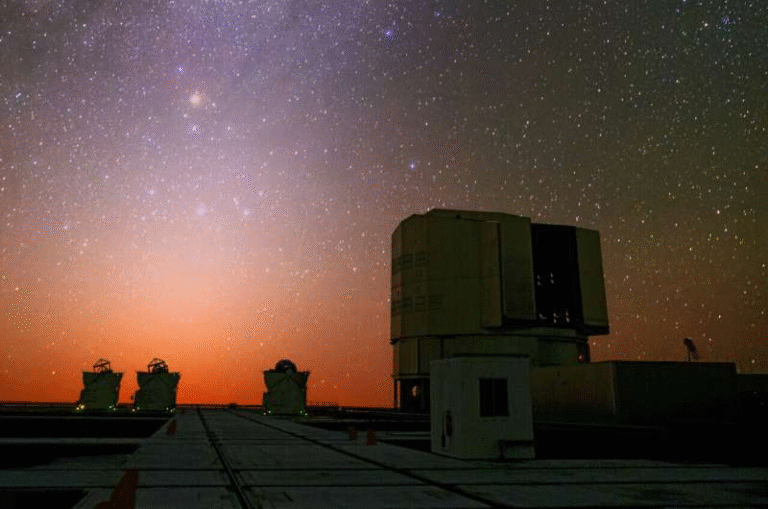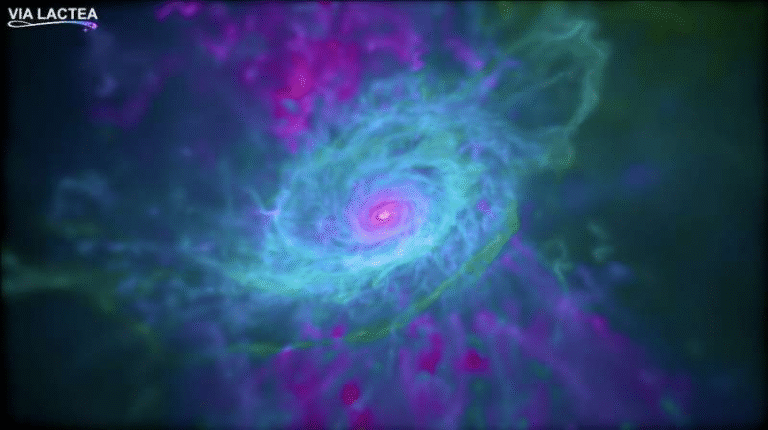NASA’s Perseverance Rover May Have Found Mars’ First Signs of Ancient Life

NASA’s Perseverance rover has delivered what may be its most exciting discovery yet: evidence in Martian rocks that could represent signs of ancient microbial life. This potential breakthrough comes from a rock sample collected in Jezero Crater, a place scientists have long suspected once held water and possibly life. Let’s go through all the details of what Perseverance found, why it’s so important, and what this could mean for our understanding of Mars.
The Rock Called Sapphire Canyon
In July 2024, Perseverance drilled into a reddish rock nicknamed Cheyava Falls, part of the Bright Angel formation in Jezero Crater. From this rock, it collected a core sample that scientists call Sapphire Canyon.
The location is significant. Bright Angel is a formation made up of sedimentary rocks, formed long ago when water carved the ancient river valley known as Neretva Vallis. This valley is about a quarter-mile wide and once funneled water into Jezero Crater, making it an ideal site to look for preserved biosignatures.
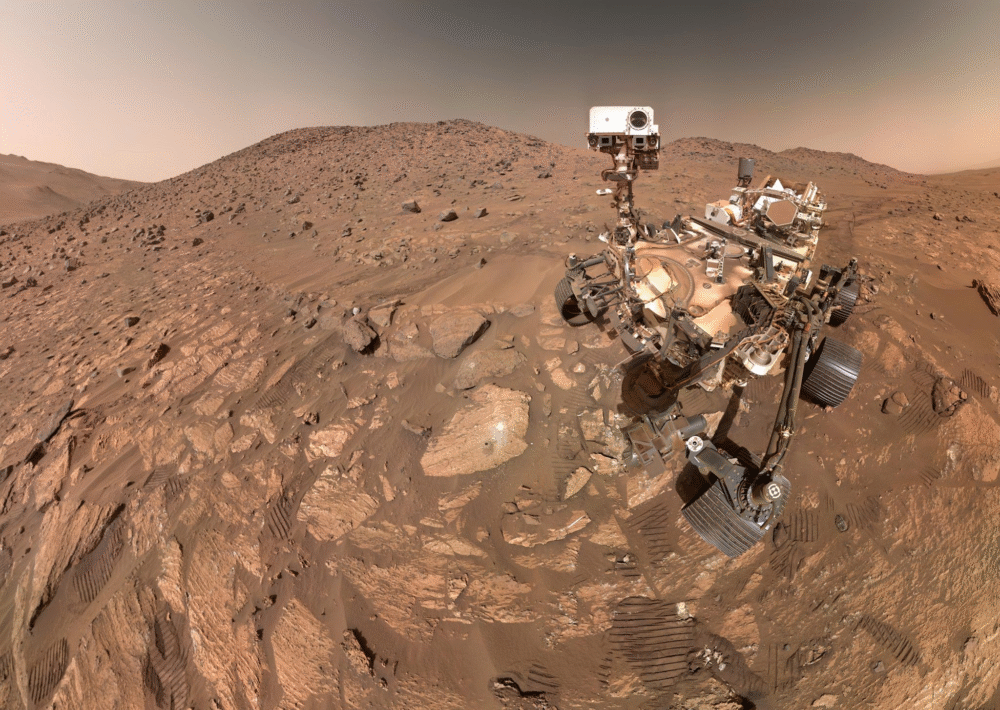
Credit: NASA/JPL-Caltech/MSSS
Why This Sample Stands Out
Sapphire Canyon isn’t just another Martian rock. Its mineral patterns and chemical composition immediately drew attention. Using two of its advanced instruments—PIXL (Planetary Instrument for X-ray Lithochemistry) and SHERLOC (Scanning Habitable Environments with Raman & Luminescence for Organics & Chemicals)—the rover revealed unusual textures on the rock’s surface.
These textures, described as “leopard spots”, show chemical reaction fronts in the rock. They are enriched with two minerals that, on Earth, often form alongside organic matter and microbial activity:
- Vivianite (hydrated iron phosphate) – commonly found near decaying organic material on Earth.
- Greigite (iron sulfide) – known to form through microbial processes in Earth’s sediments.
Adding to the intrigue, the rock also contains organic carbon, sulfur, phosphorus, and oxidized iron. On Earth, these compounds are excellent building blocks and energy sources for microbial life.
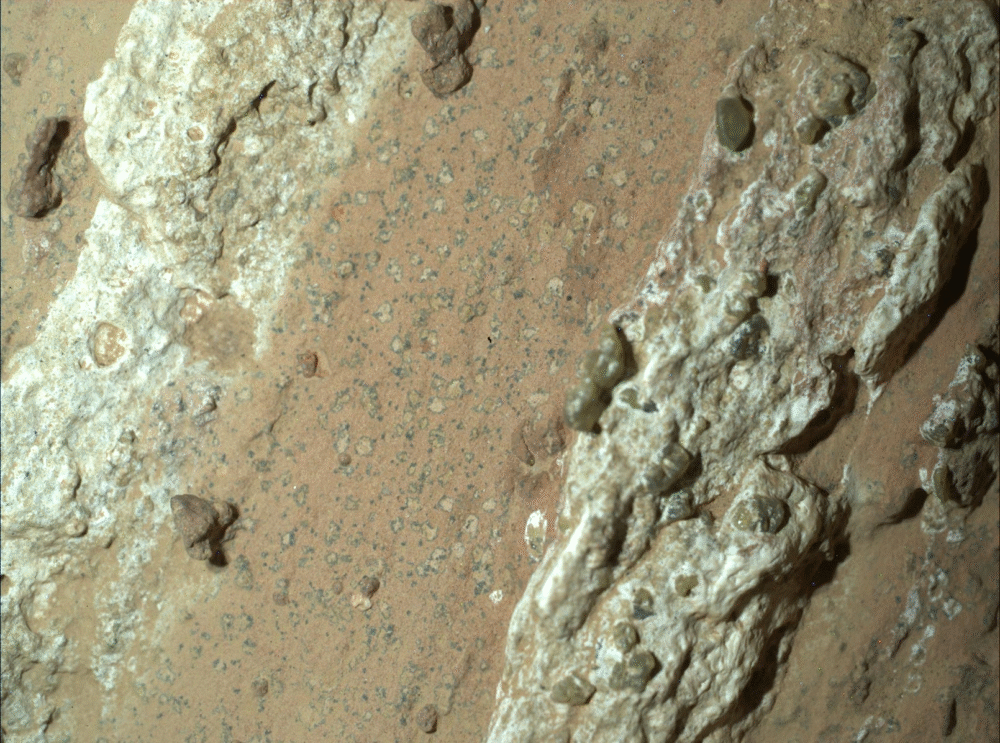
Credit: NASA/JPL-Caltech/MSSS
What Makes This a Potential Biosignature
A biosignature is any feature—chemical, physical, or structural—that might indicate past or present life. The combination found in Sapphire Canyon checks several boxes:
- Organic material preserved in sedimentary rock.
- Distinct mineral textures resembling reaction fronts.
- Iron, sulfur, and phosphorus associations that look like the outcome of electron-transfer reactions, which microbes often perform.
Scientists suspect that billions of years ago, microbial life could have used these elements as fuel. If so, the minerals we now see would be the chemical footprints left behind.
That said, abiotic processes (non-biological chemical reactions) can sometimes mimic these patterns. High temperatures, acidic conditions, or purely chemical binding reactions can also generate similar mineral assemblages. However, the rocks at Bright Angel do not show strong evidence for extreme heat or acidic alteration. This makes the biological explanation harder to dismiss, but not yet proven.
The Tools Behind the Discovery
Perseverance carries a remarkable suite of scientific instruments, and two in particular were key to this discovery:
- PIXL – This instrument performs high-resolution X-ray fluorescence spectroscopy, mapping the distribution of elements across tiny rock surfaces. It showed exactly where the minerals clustered in “leopard spot” patterns.
- SHERLOC – Equipped with spectroscopic tools and even a camera, SHERLOC identifies organic compounds and minerals. It confirmed the presence of organic carbon, sulfur, and phosphorus within the rock.
Together, these instruments painted a picture of a rock with complex mineral-organic associations, the kind that raise eyebrows when searching for ancient life.
Context Within Perseverance’s Mission
Perseverance landed in February 2021 with a clear mission: search for signs of past life and collect samples for a future Mars Sample Return mission. Sapphire Canyon is just one of 27 rock cores collected so far, but it’s quickly become one of the most compelling.
Interestingly, Sapphire Canyon comes from some of the youngest sedimentary rocks studied by the rover. Many scientists previously believed that if Mars ever hosted life, signs would only be found in the oldest rocks. This discovery challenges that assumption, suggesting that Mars may have remained habitable later in its history than once thought.
The Bigger Picture: How Scientists Judge Evidence of Life
When it comes to life detection, extraordinary claims require extraordinary evidence. NASA uses frameworks such as the Confidence of Life Detection (CoLD) scale to rate how strong a piece of evidence is. This discovery sits in the middle range: a “potential biosignature.”
That means the evidence is consistent with life but doesn’t rule out other explanations. To climb higher on the scale, scientists need more data—preferably laboratory analysis on Earth. This is why returning samples is so critical.
The Importance of Sedimentary Rocks
One reason this find is so promising is the type of rock. Sedimentary rocks made of clay and silt are excellent at preserving organic material. On Earth, they often lock away traces of microbial life for billions of years.
The Bright Angel formation’s rocks are rich in:
- Clay and silt grains – good for trapping and protecting organics.
- Organic carbon – potential fuel for life.
- Sulfur and phosphorus – essential nutrients.
- Oxidized iron – evidence of past redox reactions.
All of this makes them a prime environment to search for fossilized biosignatures.
Perseverance’s Rock Collection
Sapphire Canyon is now part of Perseverance’s growing cache of rock cores, which will eventually be candidates for return to Earth. Alongside scientific instruments, the rover also carries swatches of spacesuit materials to test how they degrade on Mars, and a weather station to monitor the environment for future human missions.
Each rock sample collected adds to the puzzle of Mars’ past climate, geology, and potential for life. But Sapphire Canyon stands out because of its unique combination of mineral chemistry, organics, and textures.
Why This Matters for Astrobiology
For decades, the question has been simple but profound: Are we alone?
Perseverance’s discovery doesn’t answer that question yet, but it brings us closer than ever before. Even if the “leopard spots” turn out to be purely chemical in origin, they reveal a Mars that was once chemically dynamic, with the raw ingredients for life present in abundance.
And if these features are confirmed as true biosignatures, then we may finally have proof that life once existed on another planet—a finding that would reshape our understanding of the universe.
Other Possible Explanations
It’s important to stay cautious. Scientists are considering alternative scenarios, such as:
- Mineral reactions driven by purely chemical processes at low temperatures.
- Organic compounds acting as catalysts without being produced by life.
- Complex geochemical reactions that mimic biological patterns.
None of these can be fully ruled out yet. This is why sample return missions and peer-reviewed analysis are essential.
Broader Implications
This discovery highlights that life’s potential on Mars may not have been restricted to its earliest history. The presence of such features in relatively young sedimentary rocks suggests that habitable conditions could have persisted longer than assumed. That means other Martian environments, even ones not yet explored, might hold similar clues.
It also underscores how electron-transfer reactions—the movement of electrons between minerals and organic matter—are central to both Earth biology and Martian geochemistry. On Earth, microbes thrive on these reactions. On Mars, whether microbes ever did the same remains the open question.
Extra Knowledge: A Quick Look at Vivianite and Greigite
Since these minerals are at the heart of this discovery, here’s a bit more about them:
- Vivianite often appears blue or greenish and is associated with wetlands, bogs, and areas where organic material decays in the presence of iron and phosphorus. Its formation on Earth is frequently linked to biological activity.
- Greigite is related to magnetite and forms in environments rich in sulfides. Some bacteria on Earth, like magnetotactic bacteria, can produce greigite.
Their co-occurrence with organics in Martian mudstone is what makes this find especially compelling.
Perseverance and the Road Ahead
This discovery is only one step in a much larger process. The rock cores collected by Perseverance are meant to be returned to Earth as part of NASA and ESA’s planned Mars Sample Return mission. These samples will undergo detailed laboratory analysis that can test for isotopic signatures, microfossil structures, and other indicators far beyond what a rover can do.
Until then, the rover will keep exploring Jezero Crater, looking for more sites like Bright Angel and adding to its collection.
Final Thoughts
The discovery of Sapphire Canyon is a milestone in Mars exploration. It’s not confirmation of life, but it’s one of the strongest hints yet. The presence of organic matter, iron and sulfur minerals, and reaction patterns consistent with microbial metabolisms makes this a find worth paying attention to.
Even if future research rules out biology, the discovery enriches our picture of Mars as a planet with a rich and complex chemical history—one that might not have been too different from Earth in its potential to support life.


